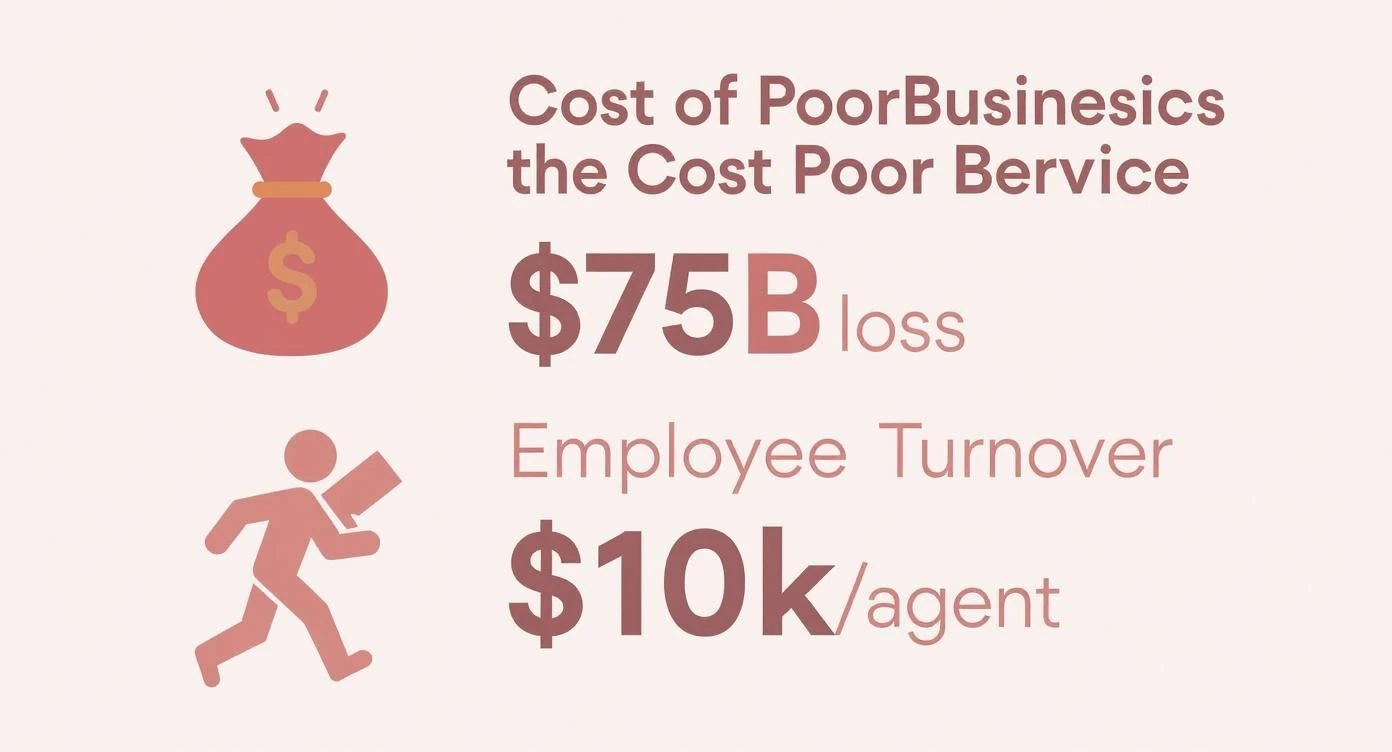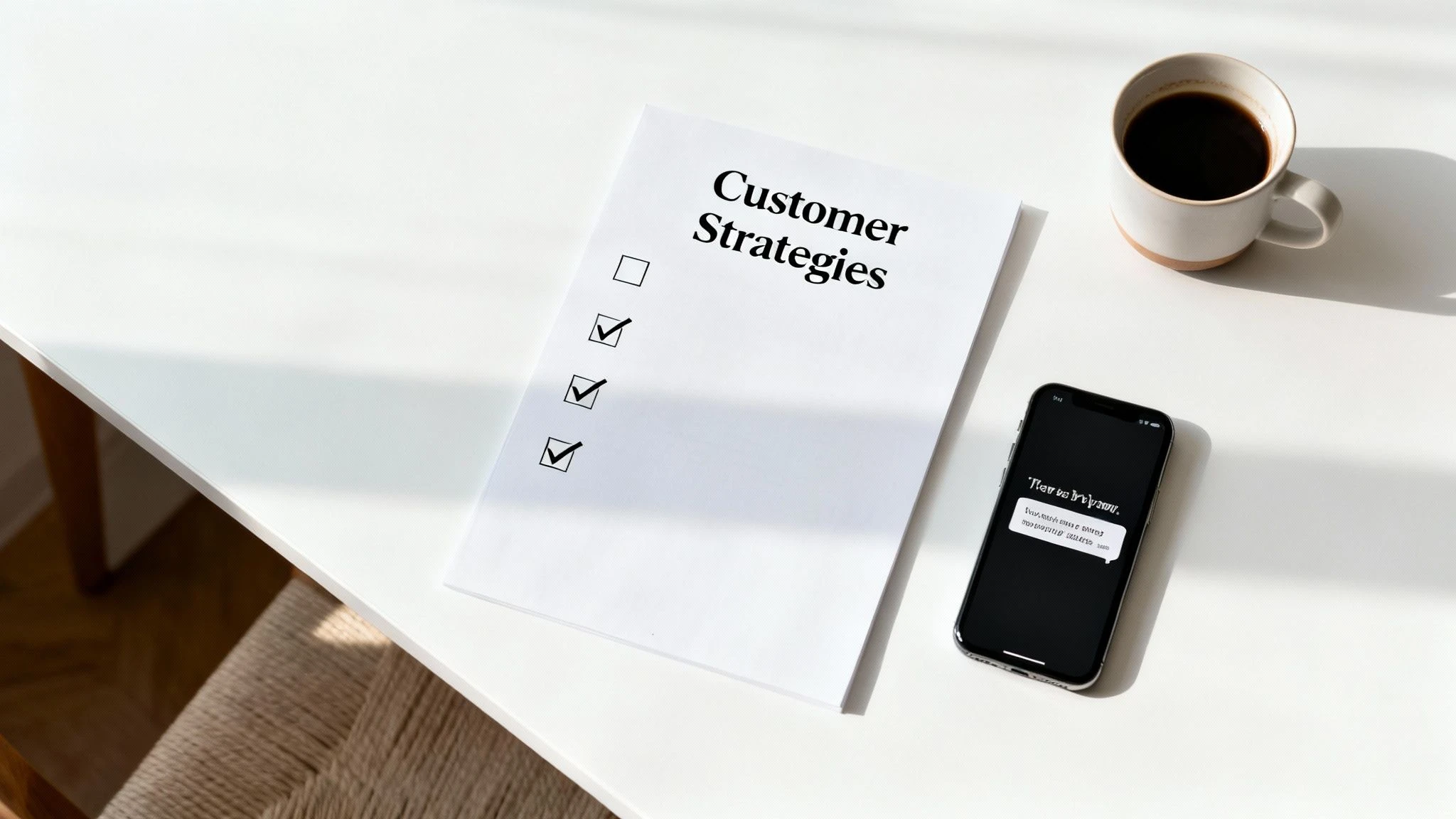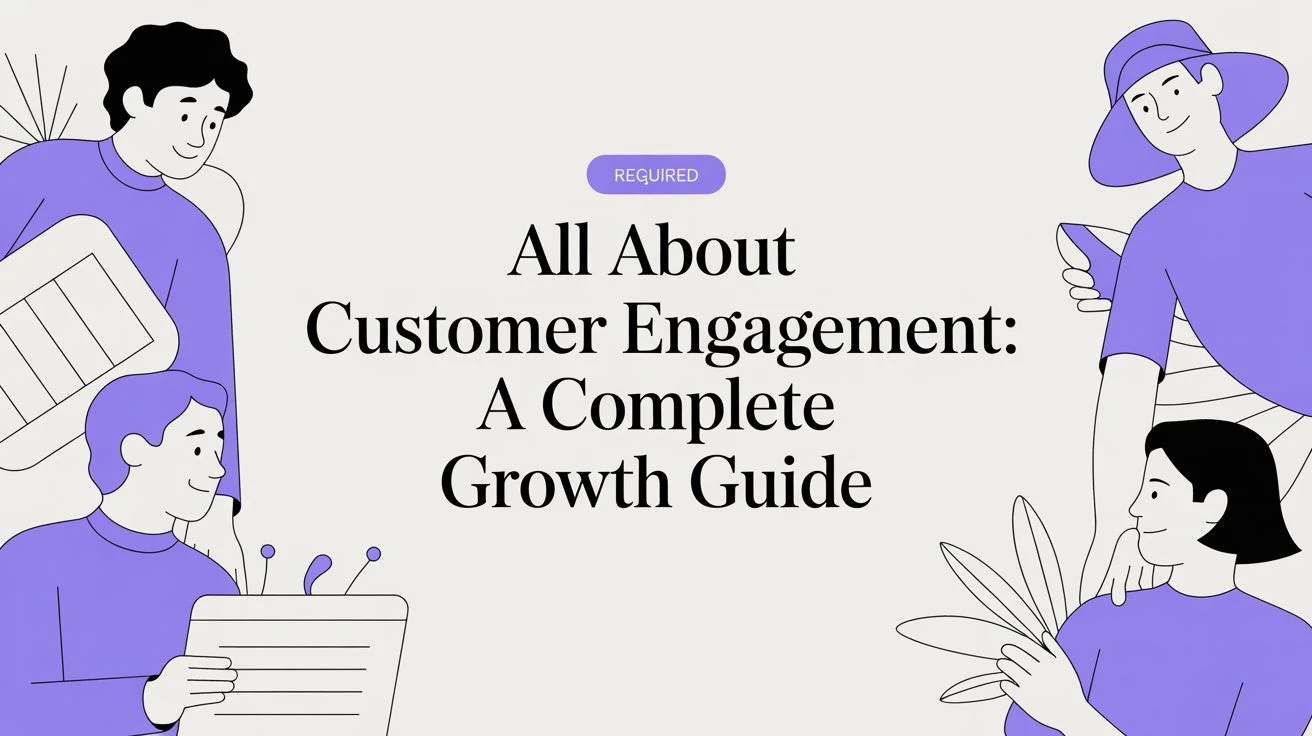Let's be honest, "customer engagement" gets thrown around a lot. But what does it actually mean for your business?
Forget the buzzwords for a second. Customer engagement isn't about a single sale or a one-off friendly chat. It's the real, emotional connection a customer develops with your brand over time, built through every little interaction they have with you.
Think of it less like a transaction and more like a conversation that never really ends.
What Customer Engagement Really Means

True engagement is the sum of every touchpoint-from the first time someone discovers your website to the thank-you email you send after their tenth purchase. It’s how they feel about your business.
Imagine your business is a garden. A single sale is like planting a seed. But real engagement is the consistent care-the watering, the sunlight, the attention-that helps that seed grow into a healthy plant that keeps producing, year after year. It’s a long-term commitment.
The Foundation of Sustainable Growth
This is where the magic happens for small businesses. When customers are truly engaged, they do more than just buy from you. They become your biggest fans. They come back again and again, spend more each time, and tell their friends why they should, too.
This powerful connection is your competitive edge. You might not be able to out-price the big-box stores, but you can absolutely win on relationships. Strong engagement builds a kind of protective moat around your business, making your customers far less likely to jump ship for a competitor’s 10% off coupon.
"Engagement is more than just interaction; it's the emotional investment a customer makes in your brand. This investment is what turns casual buyers into loyal advocates who actively contribute to your success."
The High Stakes of a Poor Connection
On the flip side, ignoring this connection is a recipe for disaster. Today's customers have very little patience for being treated like just another number. One bad experience can be all it takes to lose them for good.
The numbers don't lie. Research shows that a staggering 70% of customers will walk away from a brand after just two negative experiences. And 72% will switch to a competitor after three or fewer poor service interactions. You can dig into more of this eye-opening research on customer experience from Webex.
When you boil it all down, focusing on customer engagement is a direct investment in the long-term health and profitability of your business. It turns the simple act of buying something into a lasting, mutually beneficial relationship.
The True Cost of Ignoring Your Customers
Ignoring customer engagement isn't just a missed opportunity-it's a surefire way to hurt your business. The costs are real, painful, and go way beyond a few lost sales. It’s like a slow leak that, left unchecked, can sink the whole ship.
Think of a small coffee shop. A regular mentions the espresso tastes a bit off, but the barista is busy and just shrugs. That customer stops coming. Soon, a few others have minor issues that get brushed aside. There’s no big, dramatic failure here, just a quiet erosion of loyalty, one ignored moment at a time.
The Obvious Financial Drain of Churn
The first and most immediate hit comes from customer churn. When an engaged customer walks away, you don't just lose their last purchase; you lose all the money they would have spent with you in the future.
And the financial gut punch doesn't stop there. Now you have to spend money on marketing just to replace them. Here's a number that should make any small business owner sit up straight: acquiring a new customer can cost five to twenty-five times more than keeping an existing one. You end up paying a massive premium just to get back to where you started, a cycle that can bleed a small business dry.
It’s the classic leaky bucket problem. You can keep pouring more water (new customers) in, but if you don't patch the holes (fix your engagement), the bucket will never get full. The real work is in stopping the leaks.
This constant scramble for new faces puts a huge strain on your marketing budget, pulling focus away from nurturing the loyal customers who could have become your most profitable champions.
The Hidden Operational Strain
The damage isn’t just about lost sales and steep acquisition costs. Bad customer engagement creates a whole host of internal problems that are just as corrosive. When customers are unhappy, your team is on the front lines.
Your customer service staff takes the brunt of the complaints and frustration, which quickly leads to burnout and high employee turnover. This isn't just a morale problem; it has a serious price tag. In fact, U.S. businesses lose an estimated $75 billion every year because of poor service. Even replacing a single customer service agent can set a business back around $10,000, and that’s before you even account for the lost productivity while the new hire gets up to speed. You can learn more about the staggering costs of inadequate service at Amplifai.com.
It creates a vicious cycle that's tough to break:
- Unhappy customers lead to stressed-out employees.
- Stressed-out employees are more likely to quit.
- High turnover means you have undertrained staff and inconsistent service.
- Inconsistent service creates even more unhappy customers.
The Snowball Effect on Reputation
Let's go back to that coffee shop. The handful of customers who felt ignored don't just vanish into thin air. They go online. They tell their friends about the slipping quality and the barista who didn't seem to care.
All of a sudden, the shop's five-star rating starts to slide. New customers scrolling through reviews see the recent one-star complaints and decide to go elsewhere. That negative word-of-mouth builds a reputation that is incredibly difficult and expensive to fix.
This is the snowball effect of bad engagement. A few small, seemingly minor issues gather momentum and grow into a major crisis. What started as a simple failure to listen can become a real threat to your business's survival. Making engagement a priority isn't just a "nice-to-have"-it's a core strategy for building a brand that's resilient, profitable, and built to last.
How to Measure Engagement That Matters
If you can’t measure your customer engagement, you can’t improve it. Simple as that. Going on gut feelings about whether customers are happy won’t get you very far. You need cold, hard data to see what’s actually working and what’s falling flat.
Think of the right metrics as a compass for your business. They guide your decisions, reveal the true health of your customer relationships, and stop you from wasting time on things that don't matter. But with so many numbers to track, it's easy to get overwhelmed. The trick is to ignore the fluff and focus on the metrics that truly signal loyalty and predict long-term success.
Here's a closer look at the big three you need to watch.
Net Promoter Score (NPS)
If you could only track one thing, this might be it. The Net Promoter Score (NPS) is a beautifully simple metric that cuts straight to the heart of customer loyalty. It all boils down to a single question:
“On a scale of 0-10, how likely are you to recommend our business to a friend or colleague?”
Based on their answers, customers fall into one of three camps:
- Promoters (score 9-10): These are your raving fans. They’re the ones who will keep buying from you and, more importantly, tell everyone they know to do the same. They are your most powerful growth engine.
- Passives (score 7-8): These folks are satisfied, but that's about it. They're not unhappy, but they aren't enthusiastic either. A competitor with a slightly better offer could easily poach them.
- Detractors (score 0-6): Watch out for this group. These are unhappy customers who can actively harm your brand with negative reviews and bad word-of-mouth.
Calculating your NPS is straightforward: just subtract the percentage of Detractors from the percentage of Promoters. The final number gives you a clear, immediate snapshot of how your customers feel about you. A high NPS is one of the strongest signs of a healthy, growing business.
Customer Lifetime Value (CLV)
While NPS tells you how customers feel, Customer Lifetime Value (CLV) tells you how much they’re worth. CLV is the total amount of money you can expect a single customer to spend with you over the entire course of their relationship with your business.
This metric forces you to think beyond a single sale and focus on the long game.
Is your CLV trending up? Great! It means your customers are sticking around longer and spending more. This number is your secret weapon for making smart financial decisions.
By understanding what an average customer is worth, you can justify spending on loyalty programs, improved service, and other engagement initiatives. If a customer's CLV is $500, spending $50 to keep them happy is a sound investment.
Churn Rate
On the flip side of CLV is your Churn Rate-the percentage of customers who walk away during a specific period. Think of your business as a bucket. Churn is the hole in the bottom. No matter how many new customers you pour in, you’ll never grow if you’re losing them just as fast.
Keeping a close eye on your churn rate helps you spot problems before they get out of hand. A sudden spike could mean anything from a product bug to a new competitor swooping in. A low churn rate is a primary goal for any solid engagement strategy.
The financial hit from poor service-a major driver of churn-can be staggering.

As the data shows, U.S. businesses lose $75 billion annually due to poor customer service, with a $10,000 replacement cost for each lost service agent. These numbers prove just how costly it is when customers and staff become disengaged.
Essential Customer Engagement Metrics at a Glance
To make sense of it all, it helps to see these key metrics side-by-side. Each one tells a different part of the story about your relationship with your customers.
| Metric | What It Measures | How to Track It | Why It Matters |
|---|---|---|---|
| Net Promoter Score (NPS) | Customer loyalty and willingness to recommend your brand. | Send a one-question survey: "How likely are you to recommend us?" | It's a leading indicator of growth and a direct measure of customer sentiment. |
| Customer Lifetime Value (CLV) | The total revenue a customer will generate over their entire relationship with you. | (Avg. Purchase Value) x (Avg. Purchase Frequency) x (Avg. Customer Lifespan) | Helps you make smart decisions on acquisition costs and retention spending. |
| Churn Rate | The percentage of customers who stop doing business with you in a given period. | (# of Customers Lost / Total # of Customers at Start) x 100 | High churn is a red flag that something is wrong with your product, service, or customer experience. |
Tracking these numbers gives you a clear picture of your business's health, moving you from guesswork to informed action.
Tracking and Using Your Data
Picking the right metrics is half the battle. You also need a simple way to track and analyze them. This doesn't require a team of data scientists. NPS can be measured with simple surveys, while your existing sales records have all the info you need to figure out CLV and churn.
For businesses that want to dig deeper, dedicated tools can unlock powerful insights. For example, you can see how platforms provide detailed analytics and stats for loyalty programs on BonusQR to understand what's possible.
When you consistently measure what matters, you can stop guessing and start knowing. This data-driven approach is the key to building stronger customer relationships, plugging the leaks in your bucket, and creating a more profitable, sustainable business.
Proven Strategies for Stronger Customer Bonds

Knowing your metrics is one thing. Putting that knowledge into action is how you actually build lasting relationships. It's time to move from theory to practice with a clear roadmap of strategies that create real connection and loyalty.
These aren't complex, big-budget tactics. They are practical, proven methods any small business can use to turn passive buyers into your biggest fans. The goal is to create experiences so consistently positive and personal that your customers wouldn't dream of going anywhere else.
Personalize Every Interaction
In a world drowning in generic marketing, personalization is your superpower. It’s the difference between a message that feels like junk mail and one that feels like it was written just for them. Real personalization goes way beyond just plugging a customer's first name into an email.
It’s about using the data you already have-like past purchases and browsing history-to send relevant, timely messages. Imagine a coffee shop sending a special offer for a customer's favorite pastry on the anniversary of their first visit. That shows you're not just selling; you're paying attention.
Key Takeaway: Personalization makes customers feel seen and valued. It shows you get them, and that's the foundation of any strong relationship.
This simple shift in mindset builds incredible trust and can dramatically improve your customer engagement. It proves you see them as people, not just numbers in a spreadsheet.
Create a Seamless Omnichannel Experience
Your customers don't live on a single channel. They might see your post on social media, browse your website on a laptop, and then walk into your physical store. An omnichannel strategy makes sure this journey is smooth, consistent, and connected every step of the way.
Think about it: a customer adds an item to their cart on your website but gets distracted. Later, they get a friendly email reminder. The next day, they see a targeted ad for that same product on Instagram. This connected experience makes it incredibly easy for them to pick up right where they left off.
This isn't just a nice-to-have; it's directly tied to loyalty. Data from 18 countries shows that 54% of customer-obsessed companies saw major improvements in loyalty and retention after adopting omnichannel strategies.
Build a Community Around Your Brand
People have a natural desire to belong. When you build a community around your brand, you give customers a reason to connect with you-and each other-that goes beyond just buying something. It creates a powerful sense of shared identity.
A community can take many forms, and you don't need a huge budget to start.
- A private Facebook group for your regulars to share tips and experiences.
- Exclusive in-person events or workshops for members.
- User-generated content campaigns that put your customers in the spotlight on social media.
A local bookstore could host a monthly book club, or a salon could create an online forum where clients share styling advice. These efforts foster a sense of belonging that turns customers into a tribe of supporters who are emotionally invested in your success. For more inspiration, check out these 10 proven social media engagement strategies.
Actively Seek and Act on Feedback
Asking for feedback shows you care. Actually doing something with that feedback proves it. This creates a powerful loop where customers feel heard, and your business gets the direct insights it needs to get better.
Don't wait for people to complain-be proactive. Use simple tools like email surveys, social media polls, or just casual conversations in your store. The most important part is closing the loop. If a customer suggests adding a new item to your menu and you do it, let them know!
This approach does more than just fix problems; it makes customers feel like partners in your business. It shows their voice matters, which solidifies their bond with your brand. Of course, keeping these loyal fans is the goal, which is why exploring effective customer retention strategies in our detailed guide is a crucial next step.
Using Technology to Enhance the Human Touch

A lot of small business owners get nervous about technology. They worry it’ll make their customer service feel cold and robotic. It’s a totally valid concern. Your personal touch is your superpower, right?
But what if I told you technology could actually help you be more human, not less?
The right tools can be your secret weapon. They handle the repetitive, mind-numbing tasks so you and your team can focus on what you do best-building real, genuine relationships. It’s not about replacing people; it’s about freeing them up to create amazing customer experiences.
Think of it like a chef in a busy kitchen. The chef doesn't stand there chopping every single onion by hand. They’ve got food processors and sharp knives to handle the prep work fast. This frees them up for the real art-perfecting a sauce, plating a beautiful dish, and creating something that wows the diner. Technology is your food processor.
Automate the Routine, Not the Relationship
The trick is knowing what to automate. You want to hand off the mundane stuff to technology, freeing up your team for the conversations that really matter.
Chatbots for the Easy Questions: An AI chatbot can instantly answer things like, "What are your hours?" or "Do you have this in blue?" any time, day or night. Customers get instant answers, and your team doesn't have to repeat themselves a dozen times a day.
Marketing Automation for Perfect Timing: Instead of manually sending a welcome email to every new person, let an automation tool do it instantly. It can also send a thank-you note after a purchase or a friendly reminder when it’s time to reorder. It keeps you top-of-mind without you lifting a finger.
CRMs for Remembering the Little Things: A Customer Relationship Management (CRM) tool is basically a digital brain for your business. It remembers past purchases, birthdays, and customer preferences. This lets you personalize every single conversation and make people feel seen and valued.
Technology should handle the predictable so your team can handle the personal. When a customer has a complex problem or is feeling frustrated, they need a real person, not a bot. That’s where your team’s empathy and problem-solving skills shine.
By letting technology handle the simple stuff, your team has more time and energy for the high-value conversations that build loyalty and solve real problems.
Using AI to Be More Responsive and Personal
Artificial intelligence (AI) isn't just for mega-corporations anymore. Today’s AI tools are accessible and give small businesses a huge leg up in customer engagement. For instance, AI can sift through customer reviews and social media comments, spotting trends or urgent issues you might have missed otherwise.
To keep up with all that feedback, smart solutions like AI comment management tools can be a game-changer. These systems help you sort, prioritize, and even draft replies, making sure no customer ever feels ignored.
The goal here is to find that perfect balance. Use technology to be faster, more consistent, and more informed. Then, use all that newfound efficiency to create more space for the authentic, human connections that turn customers into your biggest fans. It's the ultimate combination of efficiency and heart.
Designing a Loyalty Program Customers Love
Let’s be real: a loyalty program is way more than a digital punch card. When you get it right, it becomes a powerful engine for customer engagement. It’s about building an emotional connection and making people feel genuinely appreciated-like they’re part of an exclusive club. The secret isn't just tossing out discounts; it's about creating a system that feels rewarding, simple, and completely in sync with your brand.
Think of it like a game. A simple point system is a great starting point. Spend a dollar, get a point. It’s straightforward, offers a clear path to a reward, and works perfectly for businesses like coffee shops or quick-service spots. That instant feedback loop is what keeps customers hooked.
Choosing the Right Program Model
But here's the thing: not all businesses are the same, and your loyalty program shouldn't be either. Different models are built for different customer behaviors and business goals. If you're looking to build a deeper, long-term connection, a tiered program might be a much better fit.
Let's break down the most common types:
- Point-Based Systems: Customers earn points for purchases, which they can cash in for rewards. This model is fantastic for encouraging frequent, smaller transactions.
- Tiered Programs: This is where things get interesting. Customers unlock new levels of benefits and status as they spend more-think "Silver," "Gold," and "Platinum" members. This model taps into our natural desire for status and exclusivity, making your best customers feel like total VIPs.
- Value-Based Programs: Instead of points, you align the program with your customers' values. For instance, a pet store could donate a small portion of a purchase to a local animal shelter. This makes the customer feel good about where they're spending their money.
The key is to pick a model that truly clicks with your audience. A high-end salon's clientele will likely be motivated by the exclusivity of a tiered system, while a local bakery's regulars might just want the simple satisfaction of a "buy ten, get one free" deal.
Making Your Program Irresistible
Once you've settled on a structure, it’s the little details that make it work. Overly complex rules or rewards that feel cheap or impossible to reach will kill participation before it even gets off the ground. Your goal is to make joining and participating feel effortless and genuinely worthwhile.
A successful loyalty program doesn’t just reward transactions; it rewards relationships. It should make your most loyal customers feel recognized and celebrated, turning them into vocal advocates for your brand.
Focus on two things: clarity and value. Make sure the rules are simple enough to explain in a single sentence. And the rewards? They need to be things your customers actually want, whether that's a free product, an exclusive discount, or a special experience they can't get anywhere else.
For a deeper dive, check out our guide on how to create a loyalty program customers will actually use. By building a program with clear benefits and a touch of fun, you create a powerful engine for repeat business and lasting customer loyalty.
Common Questions About Customer Engagement
Even with the best game plan, a few questions always pop up when you start putting customer engagement strategies into action. Let’s tackle some of the most common hurdles small businesses face and get you moving forward with confidence.
How Can I Start with a Small Budget?
You don't need a massive budget to build strong customer relationships. Not even close.
Start by focusing on high-impact, low-cost actions. Consistently replying to every social media comment, sending personalized thank-you emails after a purchase, and actively asking for feedback are all completely free.
The most powerful engagement tool you have is genuine attention. Listening to your customers and making them feel heard costs nothing but your time and effort.
Focus on creating exceptional experiences one interaction at a time. A single happy customer's word-of-mouth recommendation is often more valuable than any expensive ad campaign.
How Do I Prove It's Working?
Measuring the return on your engagement efforts is crucial. Otherwise, it’s just guesswork.
Start by tracking a few key metrics that connect directly to your bottom line, like Customer Lifetime Value (CLV) and Churn Rate. Are your customers spending more with you over time? Are fewer of them leaving for the competition? Those are your first clues.
Also, keep a close eye on your Net Promoter Score (NPS). A rising score is a powerful indicator that your strategies are building real loyalty and turning casual customers into genuine fans. These numbers give you the concrete proof you need to show your efforts are paying off.
Ready to build a loyalty program that keeps customers coming back? BonusQR makes it simple to create and manage digital loyalty cards that your customers will love. Start building stronger relationships today by visiting https://bonusqr.com.
